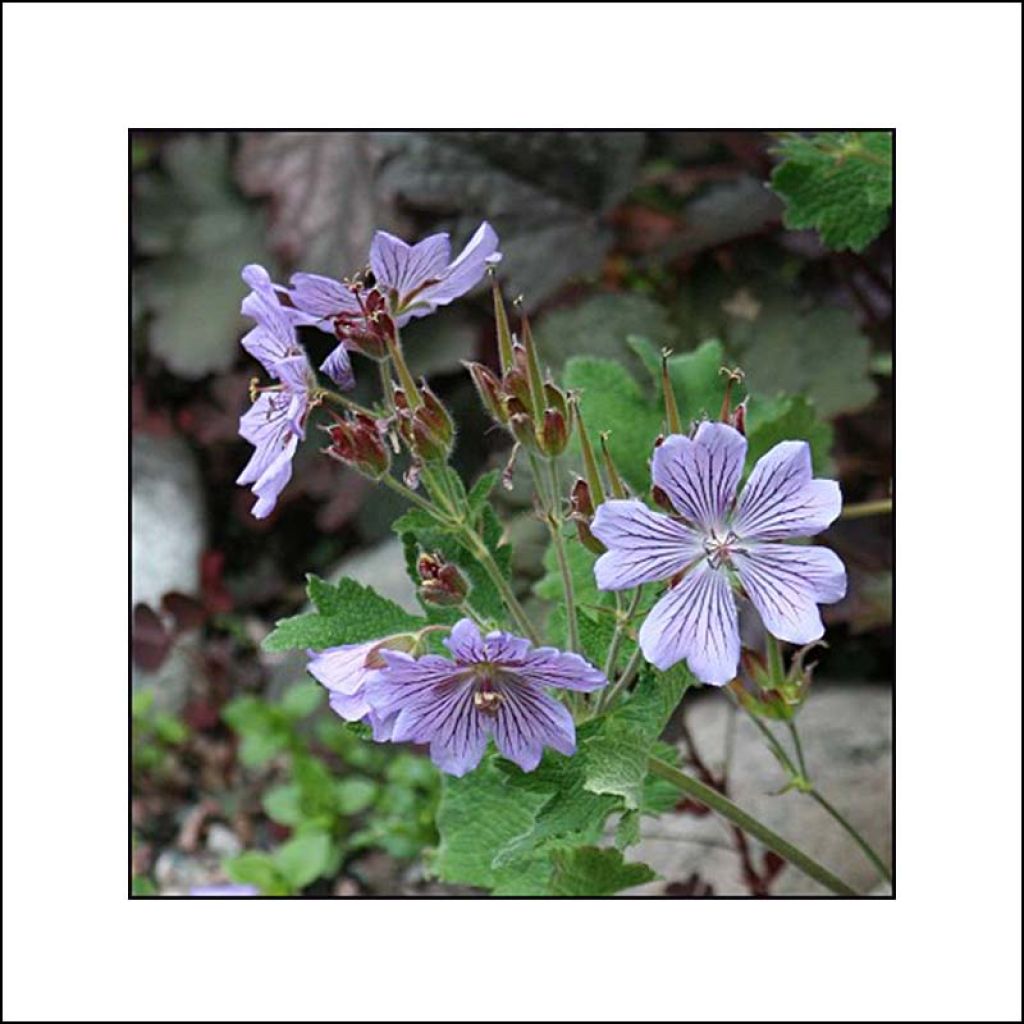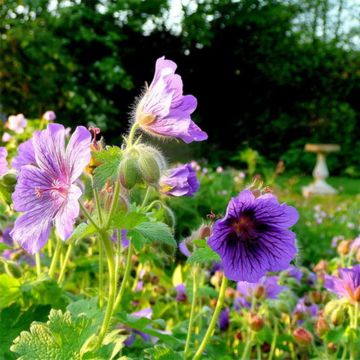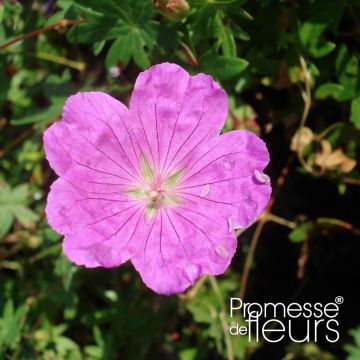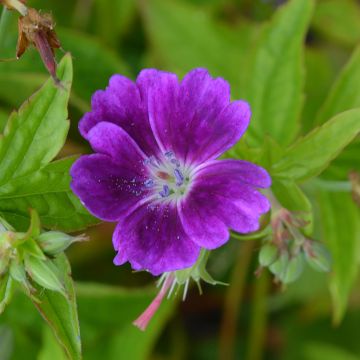

Geranium renardii Zetterlund
Geranium renardii Zetterlund
Geranium renardii Zetterlund
Renard's Geranium, Cranesbill
We eagerly awaited the passing of winter to finally discover the delicate little flowers of this geranium. It is truly very pretty, and the photos on the website are truly faithful.
Sandrine, 03/06/2021
This item cannot be shipped to the selected country
Delivery charge from €5.90
More information
Schedule delivery date,
and select date in basket
This plant carries a 12 months recovery warranty
More information
We guarantee the quality of our plants for a full growing cycle, and will replace at our expense any plant that fails to recover under normal climatic and planting conditions.
From €5.90 for pickup delivery and €6.90 for home delivery
Express home delivery from €8.90.
Does this plant fit my garden?
Set up your Plantfit profile →
Description
The Perennial Geranium renardii 'Zetterlund', also known as Fox Geranium, forms a small, fluffy and regular cushion of round and pleated sage-green leaves, very attractive. In early summer, its flowers appear with pale mauve petals, strongly veined with aubergine violet. It is an undemanding plant with interesting foliage all year round. Impeccable in all circumstances, it will thrive in all exposures, content with poor soil, even occasionally dry.
The Perennial Geranium renardii Zetterlund belongs to the Geraniaceae family. It comes from Geranium renardii, native to the Caucasus, in an area that covers Russia, Georgia, Armenia, Azerbaijan, Turkey, and Iran, mainly cultivated for its amazing foliage and adaptability to various situations. 'Zetterlund' forms a cushion of evergreen foliage, 35 cm (14in) tall when in flower, and 40 cm (0 and 16in) wide. It has a dense and well-ordered habit. The lobed leaves, circular in shape, range between green and grey. Their texture is pleasant to the touch, wrinkled on the top and velvety on the underside. It is common for the foliage to take on a lovely orange hue in autumn. The flowering takes place in May-June-July depending on the climate. The flower measures 3 cm (1in) in diameter, but it is subtly coloured in very pale mauve, with petals barely touching, strongly veined in dark violet, and the centre is crowned with dark pink stamens. The flowers are quite few, arranged in clusters along thin floral stems that stand out distinctly from the foliage. The flowering is melliferous and nectariferous.
Geranium renardii Zetterlund does not exhibit a garish and spectacular flowering as its flowers are quite few. However, its foliage does not go unnoticed when other perennials are in their resting period. This plant adapts to the sun, partial shade, and even shade. For this reason, it can be installed in a rock garden, on a wall or in borders to fully enjoy its beautiful foliage. It is interesting for its foliage that fills shaded corners nicely. For example, it will thrive at the base of flowering shrubs such as spireas, lilacs, deutzias or coronillas. In woodland, it is a good companion for acid-green euphorbias and pastel-toned lungworts. In summary, this perennial has its place in all gardens, even by the sea, even in dry gardens, or simply in pots for balconies and terraces, associated with other perennial geraniums.
Report an error about the product description
Geranium renardii Zetterlund in pictures




Flowering
Foliage
Plant habit
Botanical data
Geranium
renardii
Zetterlund
Geraniaceae
Renard's Geranium, Cranesbill
Cultivar or hybrid
Other Hardy Geranium - Cranesbill
Planting and care
The perennial geranium renardii is a very tolerant plant that accepts ordinary soil, even rocky or stony soil, even limestone, but prefers a soil that is not too rich and well-drained, in which its health will be better and its foliage more velvety. In heavy soil, it is preferable to add a good amount of coarse sand or gravel to the planting hole, or to plant in a raised bed. It is a geranium for the sun, partial shade or even shade, where it will be less floriferous. It tolerates drought well, both in the South and in the North. Cut back faded stems after flowering. It is a reliable and very robust perennial, which requires virtually no maintenance.
Planting period
Intended location
Care
-
, onOrder confirmed
Reply from on Promesse de fleurs
Haven't found what you were looking for?
Hardiness is the lowest winter temperature a plant can endure without suffering serious damage or even dying. However, hardiness is affected by location (a sheltered area, such as a patio), protection (winter cover) and soil type (hardiness is improved by well-drained soil).

Photo Sharing Terms & Conditions
In order to encourage gardeners to interact and share their experiences, Promesse de fleurs offers various media enabling content to be uploaded onto its Site - in particular via the ‘Photo sharing’ module.
The User agrees to refrain from:
- Posting any content that is illegal, prejudicial, insulting, racist, inciteful to hatred, revisionist, contrary to public decency, that infringes on privacy or on the privacy rights of third parties, in particular the publicity rights of persons and goods, intellectual property rights, or the right to privacy.
- Submitting content on behalf of a third party;
- Impersonate the identity of a third party and/or publish any personal information about a third party;
In general, the User undertakes to refrain from any unethical behaviour.
All Content (in particular text, comments, files, images, photos, videos, creative works, etc.), which may be subject to property or intellectual property rights, image or other private rights, shall remain the property of the User, subject to the limited rights granted by the terms of the licence granted by Promesse de fleurs as stated below. Users are at liberty to publish or not to publish such Content on the Site, notably via the ‘Photo Sharing’ facility, and accept that this Content shall be made public and freely accessible, notably on the Internet.
Users further acknowledge, undertake to have ,and guarantee that they hold all necessary rights and permissions to publish such material on the Site, in particular with regard to the legislation in force pertaining to any privacy, property, intellectual property, image, or contractual rights, or rights of any other nature. By publishing such Content on the Site, Users acknowledge accepting full liability as publishers of the Content within the meaning of the law, and grant Promesse de fleurs, free of charge, an inclusive, worldwide licence for the said Content for the entire duration of its publication, including all reproduction, representation, up/downloading, displaying, performing, transmission, and storage rights.
Users also grant permission for their name to be linked to the Content and accept that this link may not always be made available.
By engaging in posting material, Users consent to their Content becoming automatically accessible on the Internet, in particular on other sites and/or blogs and/or web pages of the Promesse de fleurs site, including in particular social pages and the Promesse de fleurs catalogue.
Users may secure the removal of entrusted content free of charge by issuing a simple request via our contact form.
The flowering period indicated on our website applies to countries and regions located in USDA zone 8 (France, the United Kingdom, Ireland, the Netherlands, etc.)
It will vary according to where you live:
- In zones 9 to 10 (Italy, Spain, Greece, etc.), flowering will occur about 2 to 4 weeks earlier.
- In zones 6 to 7 (Germany, Poland, Slovenia, and lower mountainous regions), flowering will be delayed by 2 to 3 weeks.
- In zone 5 (Central Europe, Scandinavia), blooming will be delayed by 3 to 5 weeks.
In temperate climates, pruning of spring-flowering shrubs (forsythia, spireas, etc.) should be done just after flowering.
Pruning of summer-flowering shrubs (Indian Lilac, Perovskia, etc.) can be done in winter or spring.
In cold regions as well as with frost-sensitive plants, avoid pruning too early when severe frosts may still occur.
The planting period indicated on our website applies to countries and regions located in USDA zone 8 (France, United Kingdom, Ireland, Netherlands).
It will vary according to where you live:
- In Mediterranean zones (Marseille, Madrid, Milan, etc.), autumn and winter are the best planting periods.
- In continental zones (Strasbourg, Munich, Vienna, etc.), delay planting by 2 to 3 weeks in spring and bring it forward by 2 to 4 weeks in autumn.
- In mountainous regions (the Alps, Pyrenees, Carpathians, etc.), it is best to plant in late spring (May-June) or late summer (August-September).
The harvesting period indicated on our website applies to countries and regions in USDA zone 8 (France, England, Ireland, the Netherlands).
In colder areas (Scandinavia, Poland, Austria...) fruit and vegetable harvests are likely to be delayed by 3-4 weeks.
In warmer areas (Italy, Spain, Greece, etc.), harvesting will probably take place earlier, depending on weather conditions.
The sowing periods indicated on our website apply to countries and regions within USDA Zone 8 (France, UK, Ireland, Netherlands).
In colder areas (Scandinavia, Poland, Austria...), delay any outdoor sowing by 3-4 weeks, or sow under glass.
In warmer climes (Italy, Spain, Greece, etc.), bring outdoor sowing forward by a few weeks.














































